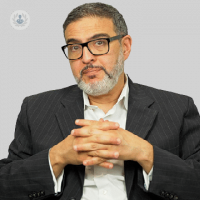Non-surgical rhinoplasty: An expert guide
Autore:For patients unhappy with the appearance of their nose, either due to its natural shape or the results of a previous surgical procedure, permanent cosmetic surgery is not the only option available. As highly respected consultant plastic and reconstructive surgeon Professor Ghassan Abu-Sittah explains in this informative article, fast and accurate improvements to the appearance of the nose can be achieved with a non-surgical rhinoplasty procedure. The revered specialist also details how the treatment is carried out, as well as what to expect from aftercare and recovery.

What are the most common reasons people choose to undergo a non-surgical rhinoplasty procedure?
There are generally two types of patient who consider a non-surgical rhinoplasty. The first group are patients who have previously undergone a surgical rhinoplasty and are unhappy in some way with the results. This may relate to the appearance of a certain part or parts of the nose but they do not want to go through the pain, surgery and expense of another surgical procedure. Therefore, they consider a non-surgical rhinoplasty where we can use fillers to camouflage those differences.
Others who may consider a non-surgical rhinoplasty are people who are also unhappy with certain aspects of the shape of the nose, such as a hump or perhaps a drooping tip. Although they would like this to be addressed, they do not want to go through surgery which requires downtime and are also concerned about the lack of certainty of results after surgery. In a non-surgical procedure, the patient is continuously looking at the result as the surgeon is using the filler to the nose and therefore, many people prefer to opt for these clinic-based procedures in order to correct the nose with a level of accuracy that surgery is unable to ensure.
Can a non-surgical rhinoplasty reduce the size of the nose?
In a non-surgical rhinoplasty, we can camouflage some parts of the nose’s natural disproportion by changing its shape. Although this may give the impression that the size has changed, in absolute terms, this is not the case.
What are the different steps involved in non-surgical rhinoplasty?
When the patient comes into clinic, we take full photographs of the nose which we use in discussion with the patient, along with a handheld mirror, to establish what type of result they would like. Once we have agreed on what needs to be done, we apply local anaesthetic cream to the nose. I usually wait for half an hour to ensure the nose is completely numb. Then, using a blunt cannula there is a single entry at the tip of the nose and we use that to inject the filler in different parts of the nose according to the plan that we discussed with the patient.
While we are adding the filler, I usually get the patient to look at themselves in the handheld mirror at each step to see whether they are happy with the additions to the different parts of the nose. Once we have added all of the necessary filler, the cannula is removed and the procedure is complete.
What type of filler is used? Is it a painful procedure?
The filler that is used in non-surgical rhinoplasty procedures is a hyaluronic acid filler which is injected under the skin of the nose. Before beginning the procedure, we apply local anaesthetic cream to reduce any pain. Although there is some discomfort associated with the procedure, patients do not report severe pain.
What are the aftercare requirements following a non-surgical rhinoplasty?
Very little aftercare is required following a non-surgical rhinoplasty. We explain to the patient that there will be some swelling and perhaps a small element of bruising at the site of the cannula the following day. Other than that, we simply advise patients to take it easy for the rest of the day after their procedure and to avoid strenuous exercise and contact sports.
Is a non-surgical rhinoplasty always an effective alternative to a surgical rhinoplasty?
A non-surgical rhinoplasty is a good alternative to a surgical rhinoplasty in the majority of cases. There may be certain individual cases where this does not apply but certainly in revision, there is a lot that can be done to correct unwanted results from a previous surgical rhinoplasty without the patient having to commit to another operation. The only downside to non-surgical rhinoplasty is the fact that the results usually last for between eight to ten months and then the treatment will need to be repeated.
If you are considering undergoing a non-surgical rhinoplasty and wish to discuss the available options with Professor Abu-Sittah, you can schedule a consultation with him by visiting his Top Doctors profile.


